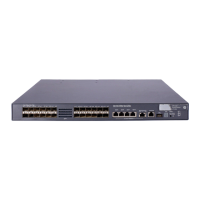102
NOTE:
• A large number of logs occupy storage space of the device, which impacts the performance of the
device. HP recommends that you disable SNMP logging.
• The total output size for the node and value fields in each log entry is 1024 bytes. If this limit is
exceeded, the information center truncates the data in the fields.
• For more information about system information, the information center and the info-center source
command, see Information center configuration in the
Network Management and Monitoring
Configuration Guide
.
Configuring SNMP trap
Enabling the trap function
The SNMP agent sends traps to the NMS to inform the NMS of critical and important events, such as
reboot of a managed device. Two types of traps are available: generic traps and vendor-specific traps.
Generic traps supported on the device include: authentication, coldstart, linkdown, linkup and warmstart.
The others are self-defined traps, which are generated by different modules. As traps that occupy large
device memory affect device performance, do not enable the trap function for all modules but for the
specific modules as needed.
With the trap function enabled on a module, the traps generated by the module are sent to the
information center. The information center has seven information output destinations. By default, the
following rules apply:
• Traps of all modules are allowed to be output to the console, monitor terminal (monitor), loghost,
and logfile; traps of all modules and with levels equal to or higher than warnings are allowed to be
output to the trapbuffer and SNMP module (snmpagent)
• Traps cannot be sent to the logbuffer. You can set parameters for the information center based on
the levels of the traps generated by each module, and decide the output rules of traps, which specify
whether traps are allowed to be output and the output destinations. For more information about the
information center, see Information center configuration in the Network Management and
Monitoring Configuration Guide.
To enable the trap function:
To do… Use the command… Remarks
1. Enter system view.
system-view —
2. Enable the trap
function globally.
snmp-agent trap enable [ acfp [ client | policy | rule
| server ] | arp rate-limit | bfd | bgp |
configuration | default-route | flash | mpls | ospf
[ process-id ] [ ifauthfail | ifcfgerror | ifrxbadpkt |
ifstatechange | iftxretransmit |
lsdbapproachoverflow | lsdboverflow | maxagelsa
| nbrstatechange | originatelsa | vifcfgerror |
virifauthfail | virifrxbadpkt | virifstatechange |
viriftxretransmit | virnbrstatechange ] * | standard
[ authentication | coldstart | linkdown | linkup |
warmstart ]* | system | vrrp [ authfailure |
newmaster ] ]
Optional.
Only the trap function
of the default-route
module is disabled;
and the trap function of
other modules is
enabled.

